Printable Version of Topic
Click here to view this topic in its original format
914World.com _ 914World Garage _ MY SDS EFI Install
Posted by: Joe Owensby Jan 30 2009, 10:08 PM
I thought I'd share some details of my recent installation of a SDS fuel injection control unit. First, I would like to thank the admins and contributors on this board for all the information available to help me make the choices I made. I spent a lot of time reviewing the posts about various benefits of the different FI systems, carbs, etc. People such as McMark, MarkHenry, Ottox914, and all-- thanks. The info here was very educational. I am posting this to maybe do my part in sharing experience. A qualifier is due up front. I am no expert in cars, engines, etc. etc. , so I would not want anyone to assume that what I post is correct. It is just what I chose to do. Comments or suggestions are also welcome.
Details: My car is a '73 1.7 that I bought new in 73. I restored the car, and started it up about a year ago. Engine is one of Jakes earlier kits. I highly recommend Jake's products by the way. I had a set of Dellorto 40's on the car. I had to learn how to set the jets, etc., and finally had the car running fairly well. I didn't like the cold nature of the carbs with no choke, and I also wanted a car that I could enjoy the radio in while driving. A lot of the noise was from the carbs. I made a sort of air filter type deal to dampen the noise, but I decided to put a FI system on the car using a stock 2.0 manifold system. The FI system on my car was 35 years old, and almost everything on it was shot. This made the decision to go to an aftermarket FI system a little easier. If I had most of the original components, I would have just tried to get new or at least good components. At least now, all the components should be relatively easy to obtain. So, the details that follow entail replacing pretty much all of the FI system components for the car.
After reading about all the available systems out there, I had narrowed it down to a Meagsquirt or the SDS. I chose the SDS because I read a few cases where people screwed up stuff on a Megasquirt and the result was something such as either blowing an engine or letting the magic smoke out of the electronics. I have seen ME screw things up, so I decided to take the more conservative route with the SDS. I am not saying anything against the Mega or Microsquirt systems. However, I can add that the SDS system did turn out to be fairly simple to install and get running- exactly as advertised. I ordered the system on a Friday, and it showed up on my door the following Tuesday, with custom length wires and all. Also, Ross at SDS was extremely helpful in helping me decide what to order, injector sizes, etc. After I got the system, I have asked him two questions about tuning, and the reply was almost instanteous. I couldn't ask for better support than I got from SDS. I'll share details on the system later.
FUEL SYSTEM:
For fuel pump, I bought a new Bosch fuel pump from a local parts supplier. I bought one of the two port filters listed for a 75 914. This was the best price I could find, and was about half of the cost from other suppliers. I wanted as many new components as I could get to hopefully get better reliability.
I bought the front fuel hose/filter kit from AA, as well as their hose kits for the upper and lower engine compartment. These worked well. I had already replaced the fuel lines through the tunnel with SST fuel lines from Chris at Tangerine racing. Great products also. I mounted the pump below the fuel tank, using a removable cover fuel pump mount from a 75 (purchased from a member here). My system had the original type fuel filter before the pump, and I added a metal fuel filter in the engine compartment, mounted where the old MPS was.
I used the original 914 steel fuel rails for the injectors, along with a new stock fuel pressure regulator from AA. This came in set to 30PSI, which was the pressure I had intended to use. I purchased an airbox manifold and throttle valve from another member here, Adidas. He only lives about an hour away, so I was able to pick up those parts personally.
More details next post.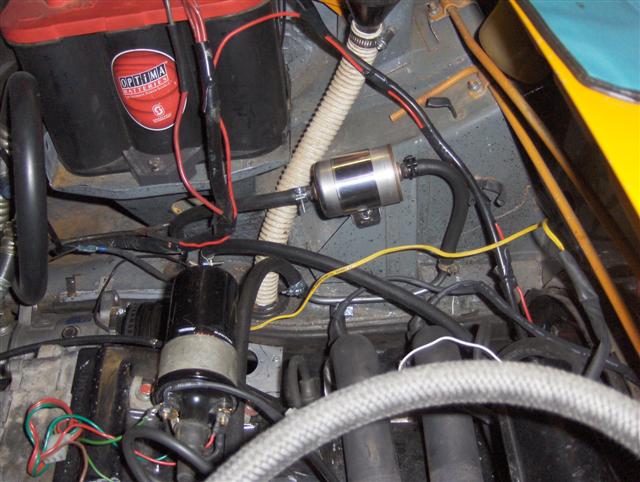
Posted by: Joe Owensby Jan 30 2009, 10:32 PM
FUEL INJECTORS:
There is a lot of discussion on this board and others such as thesamba, etc. about what injectors to use. I looked at a lot of options. Several people have used new type Ljet injectors that need slight modifications to fit the original air manifold tubes. These can be found reasonably cheap, but require making a fuel rail or modifying the injectors to accept hoses, and also modifying the injectors to fit the air manifold. Not too big a deal, but something that has to be done. I had almost decided to do this, when I fould new Bosch 0282150007 injectors that were originaly for a VW 411 or 412. These have a flow of 340cc at 3Bar, or about 268cc at 31PSI. This is about 26 pounds/hr at 31PSI, which is a pretty good value to use. These were about $56 each new from Summit. They fit the original manifolds exactly. I wanted to have new injectors as opposed to rebuilt ones, particularly since the ones I had were 36 years old. These are low impedance injectors, so I had to get the resistors installed on the SDS controller. On my engine at high load and high RPM, the injectors max out around a 50% duty cycle, so they are probably a pretty good choice. The recommended maximum duty cycle is 85%, so I am pretty good here.
SDS sytem includes wiring as specified. I ordered a system for the Djet injectors, and they sent the system with the resistors pre-wired along with wires to the installed connectors for the Djet. They don't have boots for the injectors, so I ordered boots from AA, and installed these on the SDS wires, along with a heat shrink tubing cover. In the first photo below, you can see the resistor block and the manifold pressure sensor both mounted on the firewall in the engine compartment behind the driver. This seemed like a good place to put them. I tried to route the wires as best as I could to keep them away from spark plug wires. There is also a relay mounted on the side engine compartment where a "6" oil cooler would go. This is for the aux air inlet valve for fast idle when engine is cold. You can also see two "new" red wires coming out of the rear end of the relay board. This is where I picked up the power for the SDS controller and the injectors. I tapped into the relay switched power supply that originally went to the original FI system. This tap is unfused, so i added an external fuse to the controller and the injectors, as can be seen better in the second photo.
More to come.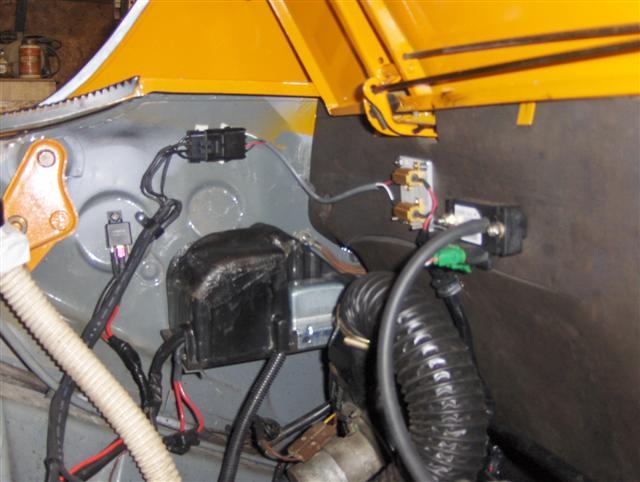
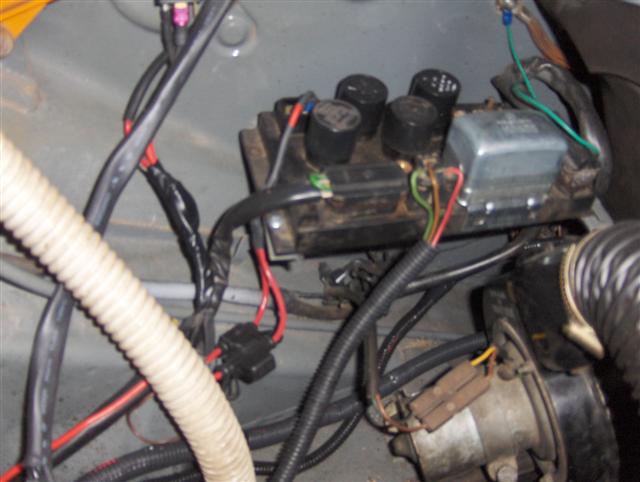
Posted by: Joe Owensby Jan 30 2009, 10:44 PM
FAST IDLE VALVE: I ordered the system with the fast idle valve. This is progammable to open to speed up the idle when the engine is cold. I have this set to close about 217 head temperature. I also plan to add a second input from my air conditioner compressor to actuate the valve when the AC is on. I routed the hose from the outlet ont he original port in the air box that went to the original fast idle valve. First photo shows the valve mounted on the side wall near the relay box.
AIR TEMP SENSOR: I mounted the air temp sensor (comes with controller system) on the back wall of the engine compartment. This ends up being fairly close to the actual inlet of the horn on the air filter inlet. I originally had the sensor mounted in the hole where the original temp sensor for the fast idle valve was located. This location read about 30 to 40 degrees hotter than the outside air, so now the sensor is on the back wall. Shown in second photo.
ENGINE TEMP SENSOR: The system came with a standard (I think Bosch) temp sensor. It just screws into the threaded port on the head near the #3 plug. This reads surprisingly close to the temp sensor I have under the #3 plug.
THROTLE POSITION SENSOR: The throtle position sensor supplied with the SDS system had a hole that mates with the original throttle valve. I made an adapter plate from a piece of 1/2 inch aluminum. Just bored a clearance hole for the shaft on the throttle valve, tapped two holes to mount the new TPS, and finally drilled holes to mount the assembly to the throttle valve. Took about 1 hour total.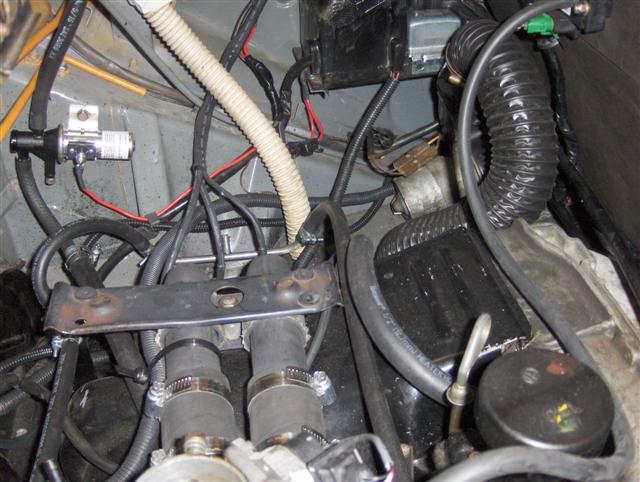
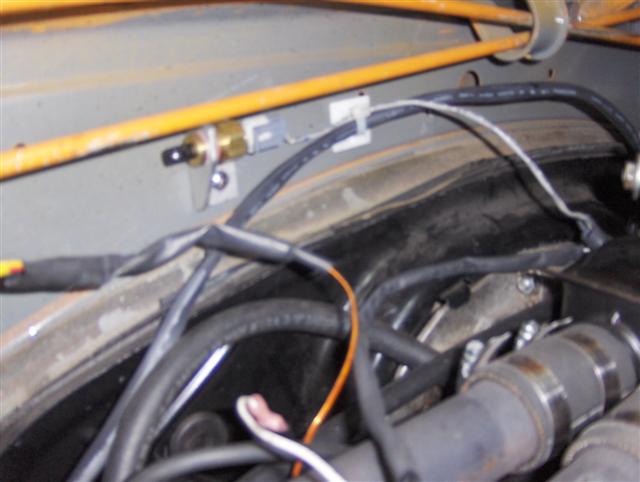
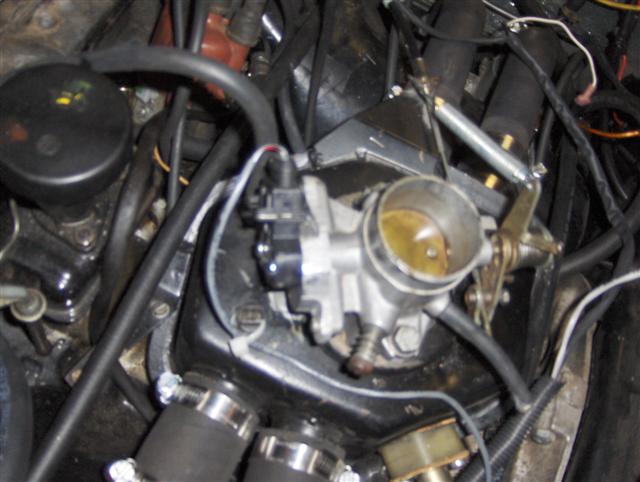
Posted by: Joe Owensby Jan 30 2009, 11:04 PM
CONTROLLER MOUNTING AND WIRING:
I considered a lot of places for mounting the controller. Hearing that water damage was the most common cause of failure, I decided to mount the controller inside the car, on the back firewall between the seats. I routed the wires to all the components to the driver's side of the car, up along the front engine shelf, and then through a 1 1/4 inch hole in the firewall. I used a rubber grommet to fit the 1 1/3 hole. I also added a piece of aluminum with a smaller grommet that I glued on the outside of the firewall insulation. I glued this on the top half, and left the bottom half open to allow drainage. The wires were routed through the firewall, and into the SDS controller. If I had it to do over, I would have had the thrugh hole located higher so it wouldn't have been behind the controller. The first photo shows the wires from the engine compartment. Second one shows wires going to the mounted controller.
The third photo shows a modification I made to the backpad to allow it to go over the controller. I just cut out a portion of the paperboard on the backpad in the area where the controller would be. I then cut out the foam in this area, and replaced it with a 1/4 inch thick piece of foam followed by a thin 1/8 or so piece of fiberboard. I then fiberglassed this to the back of the backpad, as can be seen in the photo. This created a compartment for the SDS controller, and allows air to circulate around the controller for cooling. Worked out pretty good.
I have a PLX O2 sensor mounted on the exhaust. Wires from this were run up along the underside of the motor alongside the speedometer cable. I drilled a hold in the lower firewall near where the fuel lines go into the tunnel, and routed the O2 sensor wires into the tunnel up to the console area. I have the actual controller for the O2 sensor mounted inside the center console where it drives the gauge, and there is a wire that goes back to the SDS controller to provide O2 feedback.
As ordered wire lengths for these component locations were:
Injectors from Resistor block; 26, 29, 75, and 79 inches.
Controller to resistor block 48
Controller to following. tach signal- 102, TPS 92, Fast idle 105, MAP 48, CHT 118, ait temp 92.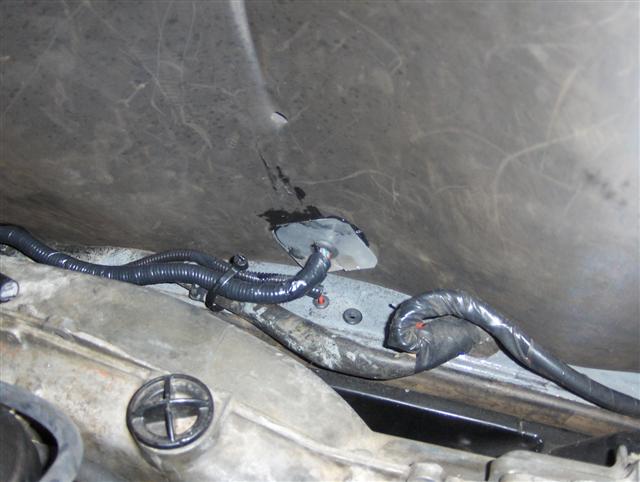
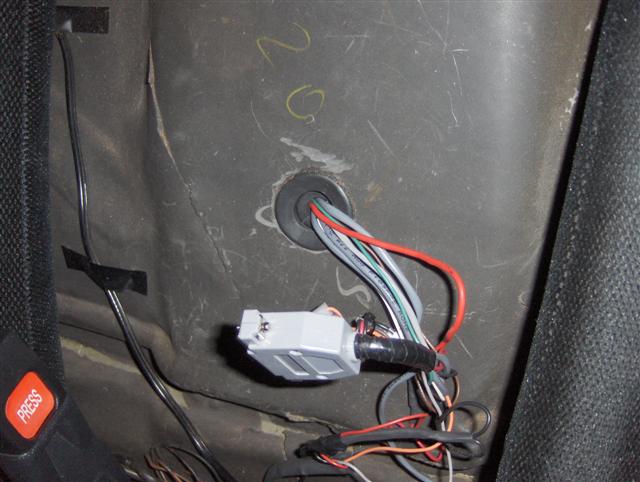
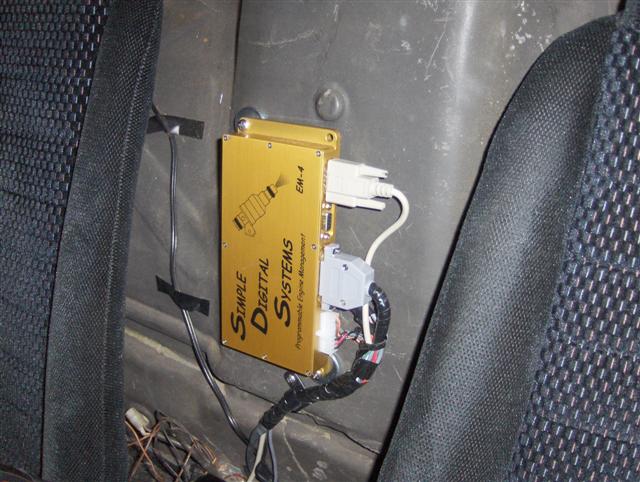
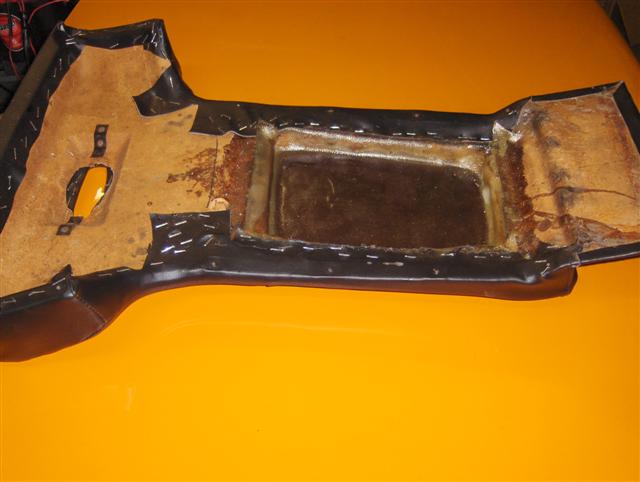
Posted by: Joe Owensby Jan 30 2009, 11:47 PM
START UP AND TUNING:
I forgot to mention at the baginning that I have a fuel only system. This is much simpler than the systems that control both fuel and spark. The SDS fuel only system operates primarily by engine RPM, Manifold pressure and changes in throttle position. These values are modified by other inputs such as engine temperature, start up conditions, and air temperature. The engine temperature input has corrections for adding extra fuel as need for the engine to run well when cold, and also to control the setting for fast idle when the engine is cold. For specific details, refer to sdsefi.com, where you can get a complete copy of their manual. Programming is done using a supplied LCD unit with pushbuttons. I made a mount to fix this to the ash tray for use during tuning. I had seen this by someone on this board, I think McMark (EDIT by McMARK: It was Mark Henry). It makes it pretty handy to do the tuning. There is also a mixture knob that enables you to adjust the mixture during tuning. The SDS unit has an O2 logging feature that is pretty neat. For tuning, you just clear the logged values, and then do a run in 3rd or fourth gear from a low RPM to a high RPM. The unit records the O2 levels for each increment of 250RPM. You then just adjust the mixture percentage to get the O2 levels you want. Photo below shows the programmer, and you can also see the gauges I added to the console. I have a digital cyl head temp gauge as well as the O2 air/fuel ratio gauge installed in addition to the std. volt and oil temp gauge. Console still needs some spiffying up.
After installing my system, I first checked out the fuel system for correct pressure, etc. I then tried to start the car; and believe it or not- it started up after only about 4 seconds of starter operation. This was with the program settings as supplied by SDS. WOW, was I amazed!!!! No magic smoke let out of anything, and I had a running engine. The original settings were just an estimated value they put in based on the specifics I gave them for the engine and injector sizes. Can you say "SIMPLE DIGITAL SYSTEMS"?? I was able to immediately drive the car down the road and make some basic adjustments using the mixture know to get a feel for what ranges of settings I needed for good mixture conrol. I did the basic tuning myself by making trial runs on a country road. Just make a full or 3/4 throttle run and then coast off onto a side road, and then review the o2 readings and make adjustments as needed.
I now have the car tuned in pretty well for all conditions except idle. The engine I have doesn't have a lot of vacuum at idle RPM, so there is sometimes some variation in the idle. I am getting this smoothed out fairly well with the combination of RPM and manifold pressure settings. I also ended up drilling out the hole in the throttle plate a little to allow the engine to idle better as the low vacuum levels didn't pull enough idle air throught the standard hole. I had to open the idle bypass screw quite a lot, and it ended up whistling. A slightly larger hole in the throttle plate fixed that problem, as I could turn the idle bypass screw back in to a reasonable level. I have also experimented with the option for just having an idle injection rate setting that can be set on the SDS systems for cars with cams that do not provide a high vacuum when idling. This works OK, so I may end up using this option. I expect to do a little more tuning tomorrow, and then remove the programming unit from the ashtray.
By the way, I made the first road trip, about 200 miles each way, on the car last week.The unit worked great. It has the option where you can turn on the closed loop control to keep the A/F ration about 14.7. This worked great when driving down the interstate at about 75 to 80 mph.
If anyone has any comments, questions, or suggestions for improvement, please let me know. JoeO
Attached image(s)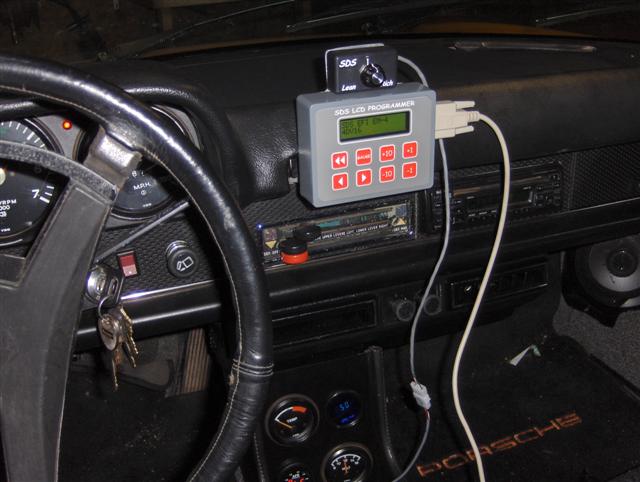
Posted by: Todd Enlund Jan 30 2009, 11:59 PM
Great post Joe!
This is the kind of info that makes this site so great. Guys sharing what they learned so that others can benefit.
I'm gonna start with IDFs, but I'll switch to FI when I can afford it.
If it's not too much to ask, what do you figure you have into the FI system? Carbs can be had pretty cheap ![]()
Posted by: McMark Jan 31 2009, 12:08 AM
GREAT WRITEUP Joe! Thanks for taking the time to share your experience.
Posted by: Mark Henry Jan 31 2009, 08:05 AM
![]() Very good write up!
Very good write up!
Watch your head temps running closed loop, if they are getting too high I'd switch back to open. On the 1.8 I took the controller/WB off for 2 seasons and never looked at my values (wife hates the gear/wires) once I did put the controller/WB back on everything was still bang on.
This is normal every day service from SDS. Absolutely no BS ever.
So how long did your install take? Actual time working on your teen.
BTW....wrong Mark on the ashtray mount....that would be me.
Posted by: stepuptotheMike Jan 31 2009, 08:39 AM
Joe, looks great!! Thanks for taking the time to write up.
How are the sounds levels on your car now?
Mike
Posted by: championgt1 Jan 31 2009, 08:47 AM
Very good writeup!
Classic thread? ![]()
Posted by: brp986s Jan 31 2009, 12:11 PM
Is emissions testing required in your locale for this car? Howabout fuel economy?
Posted by: Mark Henry Jan 31 2009, 12:47 PM
Is emissions testing required in your locale for this car? Howabout fuel economy?
If emissions is an issue then you're best off to stick with stock FI. No AM (After Market) system claims to have less emissions than stock, even though you could probably program it to pass easy. No AM system would pass visual unless you did an amazing job hiding things.
I know a guy who swaps out a stock engine every 2 years for his test. PITA
When I keep my foot out of it (hard to do) my mileage is as good or better than stock.
Posted by: jc914 Jan 31 2009, 05:27 PM
Very Nice post congrats
Posted by: stepuptotheMike Jan 31 2009, 08:11 PM
Is emissions testing required in your locale for this car? Howabout fuel economy?
Beauty of South Carolina.... no inspections, no nothing. Just pay your taxes and drive.
Mike
Posted by: ottox914 Jan 31 2009, 08:15 PM
Looks good! I would continue to work with the settings for your idle, rather than use the TPS idle programing. My ITB's provide a less stable vac. signal that the OEM plenum system, and we were able to program in a smooth, steady idle with some patience.
Good Work!
I was amazed at the mpg even with the ITB's, larger injectors, and a heavy foot. Of course, now with a turbo and at an auto cross, the mileage takes a dive, but around town and on the highway, I have hit 35mpg at 70 mph, with restrained town driving.
Posted by: Jake Raby Jan 31 2009, 08:58 PM
Very comprehensive write up...
Now you see why I use and recommend SDS over pretty much anything else.. The tech support is unparalleled and they won't treat you like an idiot if you have a question...
How is the system behaving at low RPM with that engine combo???
BTW- I set my fast idle to deactivate at 187F, when it was set higher I had issues with fuel intrusion into the oil.
I see you have V 16, I am doing some beta testing of version 16.6 with a self learning AFR target chip in use.. If it continues to work as well as it has been, this will give SDS another big boost, then we'l share details...
My 148,000 mile 912E is now getting over 40 MPG again with this chip enhancement, prior to the chip the best MPG I could attain was 34-36.....
Posted by: smdubovsky Feb 1 2009, 10:59 AM
Nice work. I had an SDS on my old Jeep. However you should relocate the air temp sensor back into the intake tract. Its needs to measure the exact air temp entering the motor not ambient.
Posted by: Mark Henry Feb 1 2009, 11:42 AM
Nice work. I had an SDS on my old Jeep. However you should relocate the air temp sensor back into the intake tract. Its needs to measure the exact air temp entering the motor not ambient.
Posted by: rdauenhauer Feb 1 2009, 12:04 PM
Is emissions testing required in your locale for this car? Howabout fuel economy?
If emissions is an issue then you're best off to stick with stock FI. No AM system would pass visual unless you did an amazing job hiding things.
I know a guy who swaps out a stock engine every 2 years for his test. PITA
Not to be arguementive or to Hijack but how many monkys performing these tests are going to be old enough to visually determine if the installed system is OE or not.
Has any one ever seen the referance photos they use ? Do they evan have referances for 35yr old cars?
Posted by: jd74914 Feb 1 2009, 12:26 PM
I have always wondered that too. There is no way that the guys who do emissions tests around here know what stock is on relatively unseen cars. And on top of that, if you claimed that the new additions were replacement parts, I don't see how anyone would really have grounds to argue.
Hyjack over. ![]()
Very nice install and writeup Joe. Thank you. ![]()
Posted by: Joe Owensby Feb 1 2009, 12:58 PM
Thanks for the comments and suggestions. Sorry for crediting the wrong Mark.
In SC, there are no emission inspections, so this is no problem. As far as cost goes, there will be no beating a set of carbs for being affordable. In fact, I am probably going to sell my set of Dell's, and I expect to get only a fraction of what I spent on the FI system. I just like FI systems. I don't have the numbers handy but the costs were in the ballpark of: $ 220 injectors, 1200 or so for the controller with valves sensors, etc. . I ended up spending a bit more because I had to buy an air box with runners, throttle, high pressure fuel pump (I think it was about 200 or so for the Bosch pump new), and the hoses and fuel pressure regulator- about 100 or so. While not mandantory, it would be nice to have an air/fuel gauge at least for tuning. I already had one that I bought to originally help me learn how to tune the carbs, so it was not an issue with me. Once the system is tuned you can take this off if you don't want to run closed loop. I have not yet decided if I want to run closed loop.
Again, the original FI systems were great. The system on my original engine probably had over 220,000 miles on it uring the first 15 or so years that I drove it. The only thing I did during that time was replace one injector, and bend the little copper followers on the throttle switch over a bit so they would be running on a non-worn set of contacts. I don't know the exact miles because the odometer died at 185000 miles several years before I parked the car.
The system on the engine I have runs pretty well, but I don't have it perfect yet. The engine really picks up at about 2000 RPM, and goes from there. It pretty much did this with carbs also. There seems to be a slight hump in the RPM values from 2000 to 2750, with a sort of plateau on up to 3500, and then about a 10% increase at 4000 and up. I am getting close to a good idle setting, but this has been the most difficult with a MAp reading of only 8 or so at idle. I almost have the cold start values tuned in by just noting the effects when I start it up in the mornings and adjusting accordingly.
Thanks for the suggestion on the air temp sensor location. I wondered if the best place would be in the manifold itself. When I had it in the location of the original cold start valve temperature sensor below the air box, it read 30 to 40 or so degrees higher than ambient. I may see if I can insert a thermocouple into the manifold to see what the actual air temp inside it is. I believe a simple relocation would be to just tap a piece of metal with the 3/8 pipe thread for the sensor, and then weld or pop rivet/epoxy it to the air box so that the sensor goes inside the box.
Thanks, JoeO
Posted by: Mark Henry Feb 1 2009, 03:39 PM
Is emissions testing required in your locale for this car? Howabout fuel economy?
If emissions is an issue then you're best off to stick with stock FI. No AM system would pass visual unless you did an amazing job hiding things.
I know a guy who swaps out a stock engine every 2 years for his test. PITA
Not to be arguementive or to Hijack but how many monkys performing these tests are going to be old enough to visually determine if the installed system is OE or not.
Has any one ever seen the referance photos they use ? Do they evan have referances for 35yr old cars?
I guess I'm being too literal, all the systems have this sort of disclaimer in the fine print.
Posted by: Brett W Feb 2 2009, 12:32 PM
Most OBD0-1 cars all mount the IAT sensor in the plenum or in one runner farthest from the TB.
Posted by: davesprinkle Feb 2 2009, 05:30 PM
Nice work. I had an SDS on my old Jeep. However you should relocate the air temp sensor back into the intake tract. Its needs to measure the exact air temp entering the motor not ambient.
This is true in theory, but in practice, putting the air temp sensor in the manifold will yield hot-start problems. This is because the temp sensor has a very slow response time -- a typical resistive temp sensor will take several tens of seconds to respond to a change in temperature. During a hot-soak, the air in the intake manifold can reach 175'F or so. When starting post-soak, the engine will evacuate this hot air from the plenum and will replace it with ambient temp air (say, 75'F) within a few engine cycles, taking only a few seconds. Meanwhile, your plenum-mounted air temp sensor will still report 175'F, thus forcing the ECU to underfuel by roughly 15% for this 100'F change in inlet air temperature.
Bottom line -- put the air temp sensor where it won't be affected by engine temp -- your firewall location is pretty good. No it won't be measuring plenum temp, but under running conditions, plenum temp IS ambient temp, within a few degrees or so, close enough to ensure that your fueling error will be substantially less than 1%. Easier to accept this than a 15% lean condition on a hot-start.
Posted by: bleucamaro Feb 2 2009, 06:37 PM
Very nice write-up. If you are still looking for some constructive criticism, you might want to check your intake tract for vacuum leaks. I would think that you should have a moderately strong vacuum signal at idle, unless you are running a huge cam. Also, you will get more accurate intake temps by having the sensor in the intake tract.
Does SDS offer a cross over threshold that changes from alpha-N to speed density for low vacuum applications?
rdauenhauer: on oddball cars, they don't know what the heck they're looking at. I passed a 944S2 with a supercharger and piggyback on it in CA. Just leaned out to 14.7 AFR at lighter loads.
Posted by: davesprinkle Feb 2 2009, 08:28 PM
Also, you will get more accurate intake temps by having the sensor in the intake tract.
As I mentioned earlier, this is a common misconception. It's easy but incorrect to propose that the intake tract location is more accurate. The reality is this: any air temp location that exposes the temp sensor to engine heat will yield LOWER accuracy. Unless you can find a temp sensor with a sub-1s response time (good luck with that), you should move the sensor away from the engine. Period.
Put the sensor under the front bumper. It'll work just fine there, and you won't have hot-start problems. (OK, I realize wiring logistics make the front bumper an unrealistic location. But at least get the sensor away from the plenum already. Maybe up under the vent by the decklid hinge?)
Use the air temp sensor to measure air temp. Use the engine temp sensor to measure engine temp. Don't confuse the two.
Posted by: Jake Raby Feb 2 2009, 08:48 PM
I place the IAT sensor in the intake tract pre- throttle body... I have placed them in the plenum as well, but the proper location is in or near the air filter.
Posted by: Mark Henry Feb 3 2009, 05:49 AM
I place the IAT sensor in the intake tract pre- throttle body... I have placed them in the plenum as well, but the proper location is in or near the air filter.
Posted by: Brett W Feb 3 2009, 10:26 AM
While your premise is good about the heat soak, it isn't a problem with a properly tuned system. I can assure you I have never had a hot start problem with the IAT located in the end of the plenum, on NA or Turbo charged vehicles. You want the ECU reading the air temp closer to going into the chamber. Air outside of the TB doesn't matter.
Another thing that comes up is the type of sensor used? Are you using a metal or plastic sensor. The metal sensors do not react as quickly and they tend to retain heat more than the plastic sensors.
Having the sensor in the intake tract ahead of the Tb means greater spreads in the temperature readings as well. This means unless the sensor has a huge range of accuracy it will not read right on the far ends of the scale. Having the Sensor located in the plenum near an intake runner will yield much less radical temp swings.
Proper tuning of your IAT corrections will make all the difference in the small things. IAT corrections are like part throttle tuning. The more time spent getting those things right, the better the car will be as a whole.
Posted by: ConeDodger Apr 15 2010, 10:35 AM
Is emissions testing required in your locale for this car? Howabout fuel economy?
If emissions is an issue then you're best off to stick with stock FI. No AM (After Market) system claims to have less emissions than stock, even though you could probably program it to pass easy. No AM system would pass visual unless you did an amazing job hiding things.
I know a guy who swaps out a stock engine every 2 years for his test. PITA
When I keep my foot out of it (hard to do) my mileage is as good or better than stock.
Probably one of the main reasons no aftermarket system claims to be better than stock for emissions is that at least here in California, the CARB (California Air Resource Board) has raided and seized records from businesses that make such claims. Big disincentive if you ask me.
Posted by: Smitty911 Apr 15 2010, 10:37 AM
Probably one of the main reasons no aftermarket system claims to be better than stock for emissions is that at least here in California, the CARB (California Air Resource Board) has raided and seized records from businesses that make such claims. Big disincentive if you ask me.
Another reason CARB should go away. I can see the need to monitor the Air Quality but these people are extorsionist.
Posted by: pbanders Apr 15 2010, 12:49 PM
This is one of the most useful threads I've seen in a while. Couple of questions, if you've answered these, sorry, I didn't see them in the thead. How much did your install cost, both cash and time for install and tuning? Second, do you experience the same problem that D-Jet has with warm starts, where because the heads cool off much quicker than the cylinders and block if you let the car sit for 15-20 minutes after shutting it off (i.e. car is warmed up, you drive to get a coffee, and restart after a short while), that the ECU sees a cold head temp and richens the mixture too much for starting (requires opening the throttle to give it more air to get it to start)?
Posted by: pbanders Apr 15 2010, 12:52 PM
Couple more things - how's your idle stability across a wide range of driving conditions? Right after cold start? Warmed up? Right after a hard run? Lights + accessories on?
Does the SDS have the capability to handle and control an active idle stabilizer?
How does the system handle altitude? No difference in running at 5000'+? I have to say that's something that modern systems are absolutely incredible at, they don't give a crap what altitude you're at.
Posted by: pbanders Apr 15 2010, 12:55 PM
One comment about the air temp sensor. Air temperature is a secondary parameter in setting the mixture, across a full range of operation it has only about a 10% effect on injection pulse width in the D-Jet system. I'd be very surprised if would ever be off enough to prevent the engine from starting. The lack of correlation of head temp to proper engine temp on a T4 configuration motor has a much more significant effect, especially on warm starting.
Posted by: ConeDodger Apr 15 2010, 01:08 PM
Brad,
I think one of the main differences is that original equipment efi, even some as old as ours perhaps - samples and adjusts 100's to 1000's of times per minute. The aftermarket systems do so much less frequently than OEM systems.
Posted by: jhadler Apr 15 2010, 01:17 PM
Brad,
I think one of the main differences is that original equipment efi, even some as old as ours perhaps - samples and adjusts 100's to 1000's of times per minute. The aftermarket systems do so much less frequently than OEM systems.
Well, the D-jet is analog, so there is no sampling rate, it's continuous. But yes, the modern OEM systems have pretty high sampling rates.
-Josh2
Posted by: ConeDodger Apr 15 2010, 01:28 PM
Brad,
I think one of the main differences is that original equipment efi, even some as old as ours perhaps - samples and adjusts 100's to 1000's of times per minute. The aftermarket systems do so much less frequently than OEM systems.
Well, the D-jet is analog, so there is no sampling rate, it's continuous. But yes, the modern OEM systems have pretty high sampling rates.
-Josh2
Sorry Josh, You are of course correct and I didn't mean to confuse the point by including dJet. I should have said even the earliest of digital systems sample many times more often than most aftermarket systems available to us. I hear Motronic is the best but I also hear it is very expensive.
Posted by: Mark Henry Apr 15 2010, 03:13 PM
I'll try to answer some of Brads questions.
Altitude adjustment is automatic, all I've ever known The owners are first and foremost homebuilt airplane geeks, the biz is at one of the Calgary airports they fly almost daily in subaru powered aircraft. Their test mule for that has gone from a 4cyl to a 6 turbo. Plus a bunch of cars of course...
I have EM4-F crankfire that I did just after 914club when on line. It would have been $1600 then, but I did a group buy and got 25% off. I had a NB but later bought a WB that was $450.
With crankfire the install is a bear because you need to fab a trigger mount and disc, engine out and fan apart. I could easily do an ugly install in a day now on a fuel or MSD only system.
Has never once failed to start, hot or cold. Always takes two revolutions as it has to "see" the sync magnet.
Control an active idle stabilizer? No clue I use the stock bleed valve.
Idle has always been stable.
Cold Start has always been like a beetle carb, a couple of pumps and it fires. Colder you have to feather the gas for 30sec. never drove below 0*C much.
I've had a fresh 914 2.0 "scrapyard special" engine with a scat C-25 cam and it had the power of a fresh 2.0 djet. I used all d-Jet intake.
I sold it and then I had it on my stock 1.8 L-jet with the d-jet plenum. Across the board you wouldn't know the difference, except for the cold start. There L-jet ruled.
The 1.8 I drove the last 3 years without the programmer or WB hooked up, once a year was all I checked.
Tuning was real close right out of the box, didn't really spend a whole lot of time on it, tweaked it on the fly, it was surprisingly fast. Crankfire is set once and forget it Just the fuel values for the most part. Only issues I have had was program error. I set the fuel cut rpm to 500 for security during storage and forgot about it, doh.
I'm moving all this gear over to my bug project and I may have the SDS back going this year, but in a bug. See my signature for that story ![]()
we'll see what happens and If I find the time to do the wee beastie.
PS I had it mounted in the stock box with a hole in the bottom, never an issue with moisture, but I would never do it again. PITA
Posted by: ConeDodger Apr 15 2010, 03:33 PM
Mark,
What kind of number would a group buy take?
Posted by: Mark Henry Apr 15 2010, 03:40 PM
Mark,
What kind of number would a group buy take?
I can't remember, 10 maybe, I only made it to 7 or 8 which was 20% off. Ross liked me and gave me my system at the 25
It's on the price list page.
Would I organize the group buy again? Hell NO! PITA BTDT....
Posted by: Larouex Apr 15 2010, 08:37 PM
I have read a number of threads on the SDS, Fuel Only option and I am going to take the plunge, I am tired of fighting the old MPS and other issues.
I have a Crane Ignition setup, so I feel good about that part of the system.
I want to order the ultimate setup for FO, so this is my list...
$1021 EM-4D 4 cyl EFI system (no ignition control)
$100 optional fast idle
$70 MAP sensor 1 Bar Ab
$90 All Black TPS kit for CCW 5/16 D shaft
$21 optional head temp sensor for air cooled engine
$165 Mixture meter with heated sensor and boss
Does this look like the right list of parts? Anything you would add or omit?
TIA,
Larouex
Posted by: Larouex Apr 15 2010, 08:43 PM
Added wide meter kit and costs summed up...
$299.00 PLX wideband meter kit
$1,021.00 EM-4D 4 cyl EFI system (no ignition control)
$100.00 optional fast idle
$70.00 MAP sensor 1 Bar Ab
$90.00 All Black TPS kit for CCW 5/16 D shaft
$21.00 optional head temp sensor for air cooled engine
$165.00 Mixture meter with heated sensor and boss
----------------------------------------------------------------
$1,766.00
Larouex
Posted by: Joe Owensby Apr 15 2010, 09:44 PM
Your estimates are pretty much correct, at least in noting what you need. I don't know the current prices. I am assuming you have all the other FI stuff from the 914. Make sure you have 4 good matched injectors. With your own control system it doesn't matter quite as much exactly which ones you have as long as the flow is in the ballpark and they are all matched in flow. You will tune it to match your motor configuration. You may need a few other things such as a couple of in line fuses, etc, but not much. Jake used to sell a complete set up , but I am not sure he still does.
The SDS only has an on-off air valve for fast idle. It works fine on my car. Idles about 1500 or so when cold. I have it set to turn off at 187F temperature on the head temp sensor. Thus, I have the fast idle until the engine warms up, then it drops to the set idle. I have cleaned out a stock aux air valve, and intend to try it to see if it gives the fast idle, and then gradually reduces the rpm as the engine warms up.
Starting the engine is fine for most all conditions I have noticed. No throttle opening is needed until started. Since I put the SDS system in and wrote the original post, I have updated the cam to one of Jake's FI cams, I think the 9550. Jake's cam for this type of FI engine is great. The car now runs perfectly over all RPM ranges, including idle. This includes back in the winter when it was cold outside, maybe down to 30 or so. JoeO
Posted by: Larouex Apr 15 2010, 10:11 PM
Thanks Joe, the cam upgrade is good note to consider. I will do that when I pull the engine for paint.
I am placing my order in the morning.
Have you been tempted to go for the ignition and crankfire upgrade?
Larouex
Posted by: Mark Henry Apr 15 2010, 10:15 PM
Is that the right TPS? take a look at my TB on the previous page. Send Ross that pic.
I might have that TPS and TB up for sale soon...
Crankfire rocks... installing it sucks, PITA but doable. you need to R&R the engine.
Posted by: hydroliftin Apr 16 2010, 09:03 AM
FUEL INJECTORS:
" I fould new Bosch 0282150007 injectors that were originaly for a VW 411 or 412. "
I think this is actually Bosch 0280150007.
Posted by: ottox914 Apr 16 2010, 12:38 PM
Have a look at the SDS install thread linked to my sig- it includes the crank fire stuff. Not impossible, but pulling the motor helps. It could possibly be done in car, but I didn't want to spend that much time upside down and backwards working left handed in the dark. I needed to pull the motor for some other work on it anyway, so it all worked out in the end.
Posted by: Joe Owensby Apr 17 2010, 07:28 AM
I had read somewhere that there wasn't too much to gain from the ignition upgrade, so I decided to go the simpler way and just use the FI portion- which was what I needed anyway. I have AC, and am using the AC pulley that most people use for a spark sensor so I would have had to consider other means of picking up a spark sensor. If I had it to do again, I would have considered buyingthe SDS with the ignition option, and then could use it if I were to later put in a Suby engine. Otto's write up on the complete unit is good.
Good luck. JoeO
Posted by: DNHunt Apr 17 2010, 08:09 AM
Here's what I did to mount the SDS ignition pick up. I used a 1/8 inch piece of steel to mount the sensor. I machined slots so the sensor could be moved in or out from the center line of the crank and the distance from the magnets (important) could be adjusted by using washers ( I didn't need any. ). It is important to remember that you have to machine 1/8 off the corresponding mounts for the cooling shroud or it will not fit. 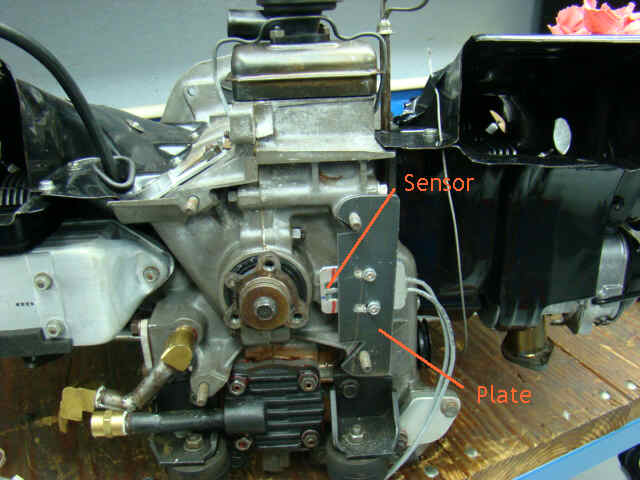
The wheel is and AC or air pump pulley that fits between the fan and the fan hub. The bright metal ring is a scribe line that is the distance the sensor is from the center line of the crank. The magnets are epoxied into the pulley.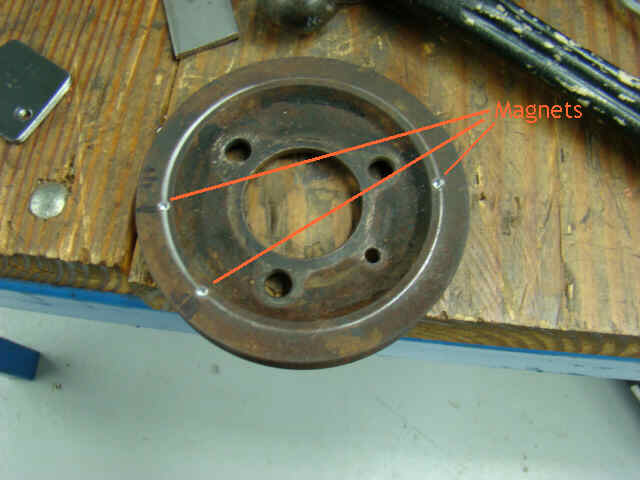
To do it this way you definitely need the engine out. I had access to a lathe (for the scribe line in the pulley) and a mill ( for relieving the cooling shroud) which helped a lot.
Dave
Posted by: Joe Owensby Aug 28 2015, 09:03 PM
Quick update. Now it is August 28, 2015. Car has been a daily driver for about 6 years. Absolutely no issues with anything, summer or winter. The only problem in 46,000 miles driven during this time was when the Mallory dizzy crapped out on me and I had to replace it with a standard dizzy. It has been so long since I have looked at anything on the FI system that I don't remember how to access it. I still carry the programmer just in case I have to troubleshoot anything. I have had it set for closed loop on the highway, and it has been running great all these years. I am now thinking about a Suby update so that I can get a better heater and defrost (even though I have SS heat exchangers in great shape). Also want about 100% more power. I am now trying to decide on what controller to use for a Suby.
Posted by: 914forme Aug 29 2015, 03:45 AM
Wow congratulations on a successful build ![]()
Why not SDS? ![]()
They do a lot of Subbies, an you have liked their product, know it semi well, and they can fill in your lack of knowledge on the Subaru side. Are there more convoluted systems out there, YES! Are you try to eke the last 10th of a HP out of a daily driver, most likely not. An NA Subaru 2.5 will be a 50% improvement on power if not more. A 3.3L will take you to 150% More Power!!! And you get into the turbos 200-300% More power. And that is with out going ![]()
Or you could learn an entire new setup, nothing wrong with that.
I have been an SDS fan for years, and see no reason to go away from it, unless you want or need functionality it does not offer.
Things that could pull you away.
Launch Control
Staged Injection
Dual Fuel - Dino gas / E85
I know there is more, but Im not thinking you need multiple boost control, with methanol injection, and a NiOx Controller, and automatic shifting. ![]()
I would love SDS to run dual fuel, but then, that is not really an issue for me, it is a want.
You would need to upgrade your unit to run coils, and since you have a 4-cyl. unit I would stick with a 4-cyl. Subaru engine.
That being said, I am sure someone would be happy to buy your complete drive train and plug an play their car. Can't wait to see the build threads ![]()
Posted by: Mark Henry Aug 29 2015, 07:01 AM
I'm pretty sure I'm the first here to use SDS, even long before Jake was using them.
Although I like the SDS, it's better on a single TB configuration with not a too wild cam as it needs a good, strong and steady vacuum signal. It can be made to work on a ITB config, but systems like MS are more flexible with wild cams and ITB's.
If you want SDS and gobs of power I would go turbo subie. For an SDS turbo app you need the ignition as well, because you will want to retard your ignition curve at boost.
Posted by: Jeff911C Apr 24 2016, 08:31 PM
I'm new to the 914 forum, but not new to modifying cars... I recently bought a 914 in 100000 pieces. It came with the SDS EM-4 efi system. The previous owner stated it ran great until he tore the car into a ton of pieces for welding up the hole from hell and the floor pans. So after he decided to ditch the project I purchased it and now I'm in the process of putting it back together. I've tried cranking the engine outside of the car to confirm the engine is good. I have everything (minus a green wire coming out of the tins on the right side of the engine) and it wont seem to ignite. I have great compression and it turns over freely but just wont seem to fire. I don't know if my MSD coil is bad or if my MSD box isn't getting the 12v it needs to power the coil. Any ideas would be awesome!
Posted by: Gplracer Sep 8 2019, 08:02 AM
Does Jake still make engine rebuild kits?
Powered by Invision Power Board (http://www.invisionboard.com)
© Invision Power Services (http://www.invisionpower.com)
